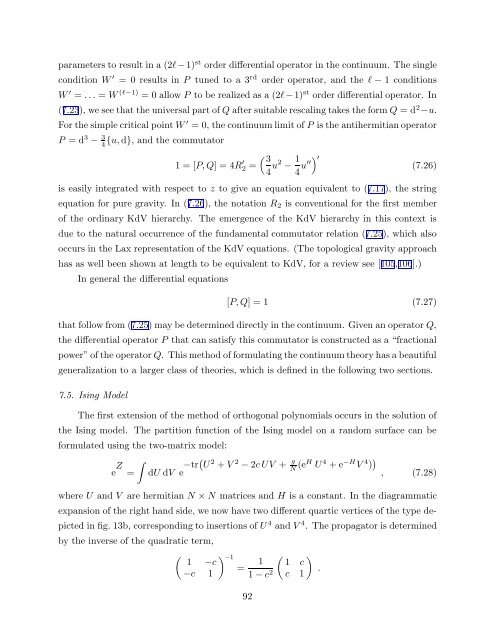arXiv:hep-th/9304011 v1 Apr 5 1993
arXiv:hep-th/9304011 v1 Apr 5 1993
arXiv:hep-th/9304011 v1 Apr 5 1993
You also want an ePaper? Increase the reach of your titles
YUMPU automatically turns print PDFs into web optimized ePapers that Google loves.
parameters to result in a (2l−1) st order differential operator in <strong>th</strong>e continuum. The single<br />
condition W ′ = 0 results in P tuned to a 3 rd order operator, and <strong>th</strong>e l − 1 conditions<br />
W ′ = . . . = W (l−1) = 0 allow P to be realized as a (2l−1) st order differential operator. In<br />
(7.23), we see <strong>th</strong>at <strong>th</strong>e universal part of Q after suitable rescaling takes <strong>th</strong>e form Q = d 2 −u.<br />
For <strong>th</strong>e simple critical point W ′ = 0, <strong>th</strong>e continuum limit of P is <strong>th</strong>e antihermitian operator<br />
P = d 3 − 3 4<br />
{u, d}, and <strong>th</strong>e commutator<br />
1 = [P, Q] = 4R ′ 2 =<br />
( 3<br />
4 u2 − 1 4 u′′ ) ′<br />
(7.26)<br />
is easily integrated wi<strong>th</strong> respect to z to give an equation equivalent to (7.17), <strong>th</strong>e string<br />
equation for pure gravity. In (7.26), <strong>th</strong>e notation R 2 is conventional for <strong>th</strong>e first member<br />
of <strong>th</strong>e ordinary KdV hierarchy. The emergence of <strong>th</strong>e KdV hierarchy in <strong>th</strong>is context is<br />
due to <strong>th</strong>e natural occurrence of <strong>th</strong>e fundamental commutator relation (7.25), which also<br />
occurs in <strong>th</strong>e Lax representation of <strong>th</strong>e KdV equations. (The topological gravity approach<br />
has as well been shown at leng<strong>th</strong> to be equivalent to KdV, for a review see [105,106].)<br />
In general <strong>th</strong>e differential equations<br />
[P, Q] = 1 (7.27)<br />
<strong>th</strong>at follow from (7.25) may be determined directly in <strong>th</strong>e continuum. Given an operator Q,<br />
<strong>th</strong>e differential operator P <strong>th</strong>at can satisfy <strong>th</strong>is commutator is constructed as a “fractional<br />
power” of <strong>th</strong>e operator Q. This me<strong>th</strong>od of formulating <strong>th</strong>e continuum <strong>th</strong>eory has a beautiful<br />
generalization to a larger class of <strong>th</strong>eories, which is defined in <strong>th</strong>e following two sections.<br />
7.5. Ising Model<br />
The first extension of <strong>th</strong>e me<strong>th</strong>od of or<strong>th</strong>ogonal polynomials occurs in <strong>th</strong>e solution of<br />
<strong>th</strong>e Ising model. The partition function of <strong>th</strong>e Ising model on a random surface can be<br />
formulated using <strong>th</strong>e two-matrix model:<br />
e Z ∫<br />
=<br />
dU dV e −tr( U 2 + V 2 − 2c UV + g N (eH U 4 + e −H V 4 ) ) , (7.28)<br />
where U and V are hermitian N × N matrices and H is a constant. In <strong>th</strong>e diagrammatic<br />
expansion of <strong>th</strong>e right hand side, we now have two different quartic vertices of <strong>th</strong>e type depicted<br />
in fig. 13b, corresponding to insertions of U 4 and V 4 . The propagator is determined<br />
by <strong>th</strong>e inverse of <strong>th</strong>e quadratic term,<br />
( ) −1<br />
1 −c<br />
= 1 ( )<br />
1 c<br />
−c 1 1 − c 2 c 1<br />
92<br />
.
















